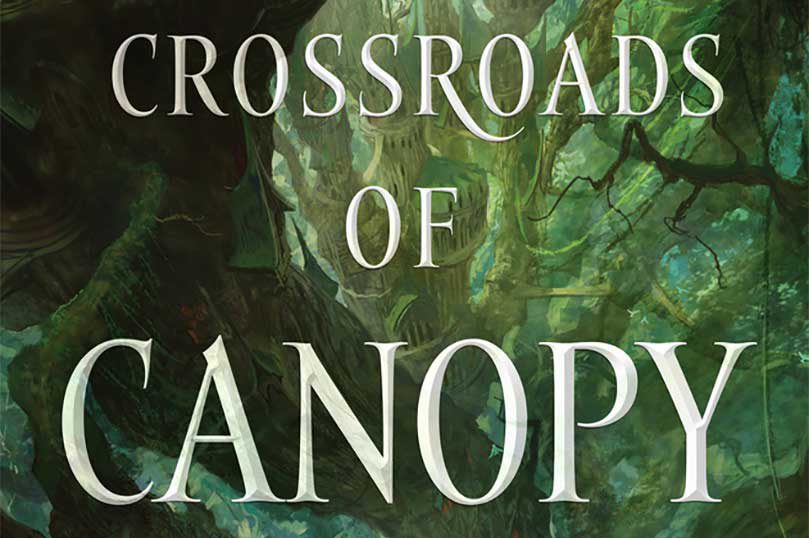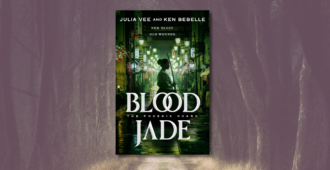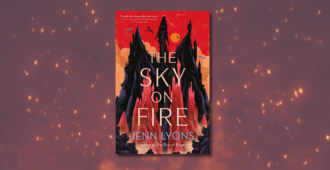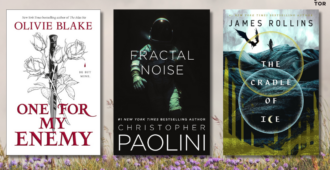opens in a new window Welcome back to Fantasy Firsts. Today we are sharing an interview with Aurealis and Ditmar Award-winning author Thoraiya Dyer about her debut novel Crossroads of Canopy. This highly-anticipated novel is set in a mythical rainforest controlled by living gods and will become available on January 31st. You can sneak a peek of it here!
Welcome back to Fantasy Firsts. Today we are sharing an interview with Aurealis and Ditmar Award-winning author Thoraiya Dyer about her debut novel Crossroads of Canopy. This highly-anticipated novel is set in a mythical rainforest controlled by living gods and will become available on January 31st. You can sneak a peek of it here!
Crossroads of Canopy is set in a giant, rainforest world, and you drew upon a lot of scientific research to imagine this realm. What was some cool facts about this environment you were excited to include in the book? Or, was there something you really wanted to mention but couldn’t find the right spot for?
I was excited to include monsoonal weather patterns, aka the “big wet” in northern Australia.
In the temperate south of the continent, we have cold, rainy winters and hot, dry summers. However, in the tropical top end you get something like 75% of the annual rainfall dumped all at once in the summer (although they wouldn’t necessarily call it summer; the locals observe something closer to a six-season cycle.) Between October and February, Darwin gets an average of 1267mm rain. Which is a pretty cool fact!
On a trip to Nepal, I remember using elephants to get across a river because the monsoon had just finished and jeeps were useless.
Yeah. Monsoons. Exciting!
What else. Gap-axe wood really is too hard to cut into without ruining your axe. Fish really can climb up waterfalls. Sandpaper fig leaves, while not to my knowledge recorded as being used for depilation, are pretty good for smoothing spears. Sun bears don’t hibernate in the real world, but their appetite for honey and co-evolution with the tualang tree has produced in the latter a glassy, slippery trunk which prevents bears from climbing the trees and keeps the hosted giant honey bees, Apis dorsata, happy and safe.
As for things that didn’t fit, when I first tried to convince my agent, Evan, that a rainforest setting would be a good idea for a fantasy novel, I’d just seen a brilliant exhibition at the Australian Museum on the Aztecs. The words “jaguars and sloth gods” may have flown excitedly from the keyboard.
I found a place in Canopy for jaguars and their souped-up versions, the chimera. Possibly sloths got a mention once or twice, but the sloth god itself got canned.
Sorry, sloth god.
Greek mythology has a subtle influence in this worldbuilding along, including Canopy possessing its own pantheon of gods and goddess. How did you decide on these thirteen deities and their specific ruling “specialties”?
In the Greek stories of Odysseus and Atalanta, which inspired many of my characters and their arcs, you find prominent mention of the following immortals: Artemis (wild animals), Aphrodite (love), Zeus (thunder, ruled the other gods), Rhea (mother of gods), Hermes (emissary, travel, trade), Helios (sun), Thetis (sea) and Poseidon (also the sea).
Because I wanted things to be cyclical with reincarnation, not linear with mother and father gods, Rhea was left out, and Zeus became a tamer, lightning-only type of god. Canopians didn’t travel much outside the forest, so Hermes got cut. Canopians consider the sea to be practically mythical, so Poseidon didn’t survive, either. That left wild animals, the sun, and a freshwater goddess of the monsoon.
Love was an interesting one. If you look at the religion of the Indus Valley civilization, which preceded Hinduism in Nepal, you find a mother goddess, a father god, deified animals and plants, indications of water worship, and giant stone genitalia.
No mention of love.
I combined love with the sun and kept it, because I was doing the compromise thing. If you look at the geographical half-way point between Nepal and Greece, you find Ishtar, the Babylonian goddess of fertility, love and war.
If you visit the Temple of Eshmun near Sidon, Lebanon, you find hundreds of marble statues of babies. Eshmun was a Phoenician god of healing. His origin story goes like this: He was born an eighth son in Beirut. As he grew into a young man, Ishtar/Astarte romantically pursued him, to the point where he fatally castrated himself with an axe. She then resurrected him and turned him into a god.
He was the patron deity of Sidon from about 500BC. If your child was sick, you’d have a stone replica carved and sent to the Temple in the hope that Eshmun would heal them. No matter where they are in space or time, no matter what they believe, people want to keep their children safe.
In Canopy, the god Odel, Protector of Children, holds a special place in my heart.
Many characters seem to leap from great heights in a death-defying way! How much climbing research (or hands-on experiences!) went into this book?
Here’s where I confess that I suck at rock-climbing. Once, I abseiled with my uncle into this amazing cave system in Canada. We dropped down seventy metres into pitch blackness. Waited for pumps to evacuate water from “the birth canal” before squeezing through it. Endured waterfalls in the face and having to balance in foot-width, ice-cold watercourses to avoid touching and ruining the crystal-covered walls. All that was fine…but climbing back up? Ahahahaha! Talk to my stepson. He’s good at that stuff. I’m an armchair Ninja Warrior.
My stepdaughter advised me to google the extreme climber known as the Monkey Man. So I’m confident in humankind’s ability to do the things I described. Just not me personally. Although I have stripped off a bit of bark and inadvertently grabbed a spider before. So there’s that.
The idea of one having a great destiny is what motivated Unar to start her adventure. Do you, too, believe we all have some sort of fate awaiting us?
I’m a scientist. I believe in statistical likelihoods. Which, I admit, can sometimes seem like destiny.
Crossroads of Canopy is your novel debut, but readers mostly know your award-winning short fiction. What are the challenges between writing short versus writing longform?
I think many years of writing short fantasy fiction made me not only succinct, but enamoured of the mysteriousness of my succinctness. One real challenge for me was to flesh things out in this manuscript. How did Unar and Aoun meet one another? In a short story that’s not my problem! What are they wearing? They have insects and bark, you work it out! Except, no, here it’s my job to make sure you smell the patchwork of pressed leaves, see Aoun sitting by the closed Gate of the Garden, and feel the silk as you stroll through the market.
If you could be a goddess from any mythology, who would you choose and why?
Artemis, for sure. I like deer and dogs and I wish I was better at archery.
Buy Crossroads of Canopy here:
opens in a new window opens in a new window
opens in a new window opens in a new window
opens in a new window opens in a new window
opens in a new window opens in a new window
opens in a new window opens in a new window
opens in a new window
Don’t forget to follow Thoraiya Dyer on Twitter (@ThoraiyaDyer) or visit her website.






